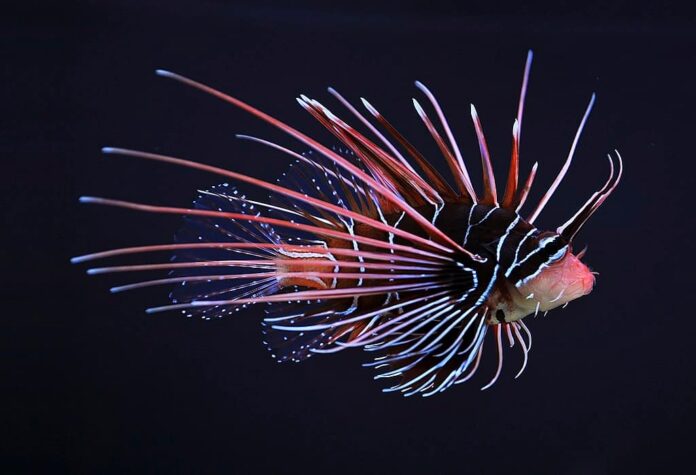Venomous fish is a species of fish that can be fatal to humans because of the strong mixtures of harmful toxins. A simple sting or touch can be very dangerous or deadly, and that is the fish that we should watch out for. According to the research, there are at least 1,200 species of venomous fish out there in the water. We are going to talk about some of the most common venomous fish that divers and swimmers are likely to encounter. Feel free to check out the list and see if you have seen any of them before.
1Fang-Tooth Blenny

By the look, no one would expect this normal-looking fish to be one of the venomous fish with deadly bites. A fang-tooth blenny has 2 enlarged grooved canine teeth in the lower jaw for which it gets its name. Each fang is equipped with venomous buccal glands, and it can deliver venom with pressure to the glands. The sole purpose of the canine teeth is to defend itself or its territory only. When seriously threatened, it will open its jaws wide to bear its teeth. Its venom reduces the blood pressure of the predators and relaxes their jaw so that it can escape. The fascinating thing about its venom is that it targets the body’s opioid receptors. This also means the venom of fang-tooth blenny can be a potential new painkiller for human use.
There are several fang-tooth blenny species, but only one group has venom glands that produce at least 3 types of toxin. Those include enkephalins, neuropeptide Y, and phospholipases. Among the venomous fish on the list, this one is the least dangerous because of its small mouth. The bites can be quite painful and surprisingly deep, but the envenomation of humans by this species is unlikely. However, you still should never attempt to hand capture or hand feed a fang-tooth blenny. Fang-tooth blenny occurs widely across the Indian and Western Pacific oceans, and the Great Barrier Reef, especially in shallow water environments. Despite having venomous bites, this fish species feed on just algal filaments, bryozoan stalks, coral mucus, and fish eggs. Their population is declining because of climate change.
2Lionfish
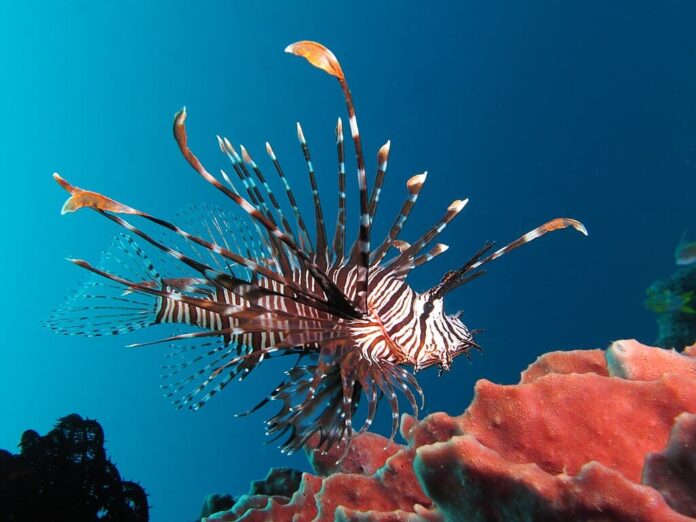
You have to know about this species if you love to dive, scuba dive, or swim because you will come across one. Lionfish is a fascinating and unique-looking fish that often attracts a closer look from swimmers out there. This venomous fish is found throughout the Atlantic Ocean, the Caribbean Sea, and the Gulf of Mexico. As a colorful fish, lionfish has brown, red, or white stripes that cover its whole body. At the same time, it also has fan-like fins and tentacles that makes it look very unique among the others. The dangerous part is the spines that contain a venom that it uses as a protective mechanism against other fish. In case the venom spreads rapidly (usually from the fingertip sting), it can decrease blood flow which leads to tissue death.
A lionfish’s venom consists of neuromuscular toxin that is similar to cobra venom when it comes to toxicity. It can deliver venom when its spine penetrates the skin of predators or curious and unsuspecting humans. Lionfish is not aggressive, and human stings are usually accidental. The pain level depends on how deep the spine penetrates the skin. Common symptoms from a lionfish fish include bleeding, bruising, numbness, redness, swelling, and throbbing pain. Although a lionfish fish is unlikely to kill humans, there are people who are allergic to its venom. This can lead to anaphylaxis shock along with allergic reactions like cardiac arrest, fainting, fever, shortness of breath, and swelling. A sting from this species can be excruciating, and you have to take care of the wound as soon as possible.
3Reef Stonefish
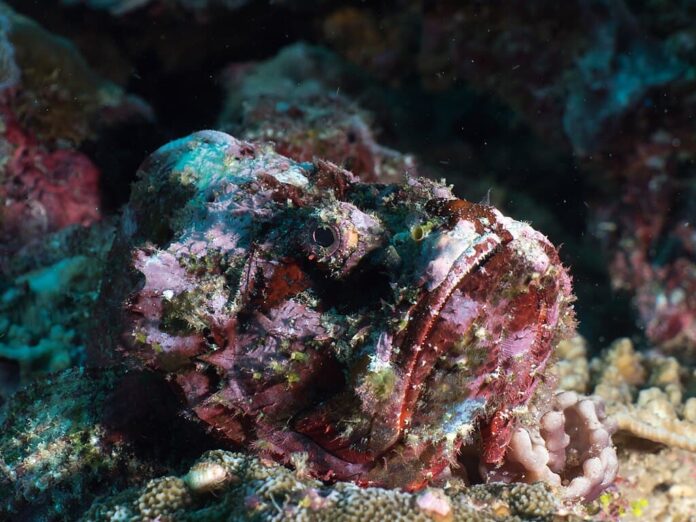
The reef stonefish is both dangerous and venomous because this species is extremely good at camouflaging. At a glance, this venomous fish looks just like an encrusted rock or a lump or coral. Accidentally step on them, and the nightmare begins even if it is broad daylight on the surface. A reef stonefish has 13 stout dorsal fin spines that can inject an extremely painful venom. While most fish swim away when disturbed, this one erects its venomous dorsal fin spines instead. Reef stonefish are not aggressive, and they prefer to stay motionless in their habitats waiting for prey. As the most venomous fish in the world, its venom can cause intense pain and many deaths. At the same time, the venom has both cardiovascular and neuromuscular toxicity which is extremely dangerous.
In fact, its venom is strong enough to kill an adult person in less than an hour without immediate treatment. This species is widely distributed throughout the tropical marine waters of the Indo-Pacific ocean. You can also find them in Australia, from the Great Barrier Reef and Queensland to northern New South Wales. They often live on coral bottoms or rubble, often under ledges or rocks but they also bury in the sand sometimes. There are occasions when they are washed up on beaches or near shorelines where humans may step on. As ambush predators, they usually wait for prey like crustaceans and fish to swim past before striking with incredible speed. Despite being a master of camouflage, this venomous fish still has predators which are rays and sharks.
4Scorpionfish

Looking very similar to lionfish, this flamboyant fish is also very venomous. A scorpionfish has toxic venom in its dorsal spines that can deliver very painful stings to humans and other predators. Many scorpionfish species have brightly colored pectoral fins that also function as a warning of their venom. The common symptoms include blisters, bruising, numbness, swelling, tingling, and tissue shedding at the wound site. Their sharp spines contain extremely potent venom that can cause intense throbbing pain that lasts for up to 12 hours. In severe cases, it can also cause decreased blood pressure, hallucinations, nausea, seizures, slow heart rate, tremors, vomiting, and weakness.
When not wishing to draw attention, they often tuck their fins away in order to camouflage. Scorpionfish are ambush predators, so they usually lie camouflaged on the reef or sea floor waiting for a meal to swim by. In a blink of an eye, scorpionfish attack crustaceans, small fish, or snails at great speed. Sometimes they also use their venom to stun prey before eating them if they have to. They spend daylight hours resting in crevices, and they only hunt at night. The most common predators of this venomous fish are large snappers, rays, and sharks.
5Stargazer
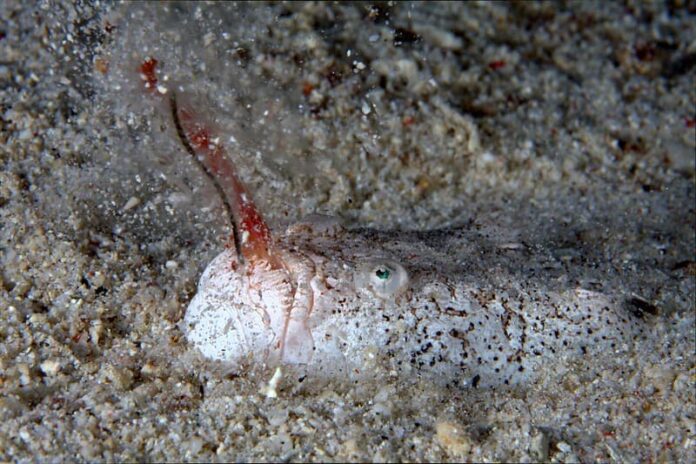
Such a beautiful name for a dangerous fish that looks nothing like the name describes. The combination of the ability to deliver both electric shock and venom makes stargazers nothing but pain. At the back of their eyelids, a stargazer has two big venomous spines that can also give an electric shock. Accordingly, their altered eye muscles can cause the electric shock of over 50 volts in electrical organs. This is not enough to kill humans, but it can cause extremely painful and local swell. Other common symptoms are heat, redness, and puncture wounds with an extra taste of electrical power and shock. Stargazers are not aggressive toward humans, and they will not cause any harm unless disturbed or threatened.
As an elusive fish, stargazers live in shallow waters where they often bury themselves under the sand or mud. When burying, only its eyes and mouths and visible so that the prey can’t notice them. Their common habitats are in the Atlantic Ocean, the Mediterranean, and deep saltwater worldwide. It attracts prey by a worm-like attachment that lures prey into its mouth for an easy and quick meal. Thanks to the eyes that position on top of its head, a stargazer can always locate and catch its prey. Their diet consists of crabs, crustaceans, and small fish that are unfortunate enough to cross paths with them.
6Waspfish
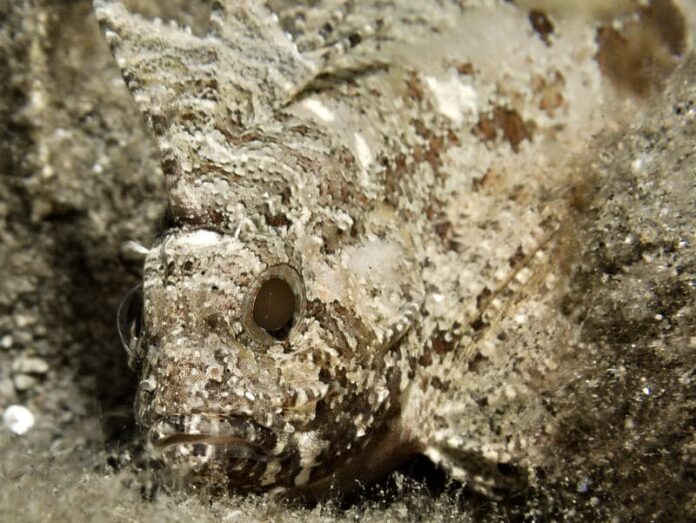
Cockatoo waspfish or waspfish is one of the venomous fish that delivers painful stings just like wasps do. As you can see, it has a long dorsal fin that rises up like a cockatoo crest; hence the first name. This one is actually a relative of the dangerous scorpionfish, but less deadly. It gets its name from the venomous spines in its fins that can inflict painful stings on anything that touches it. In case you come across one of these, it is a better idea to maintain your distance. Although not always deadly, the painful sting underwater can be difficult to tolerate for some.
Growing up to 15 centimeters (6 inches) long, waspfish are not good swimmers. They generally sway gently and slowly from side to side like a dead leaf. This fish species live on the bottom of warm waters of Western Pacific waters from Japan down to Australia. Their common habitats are bays, coral reefs, and sheltered estuaries about 20 meters deep in temperate and tropical waters. Since they are bottom-dwellers, these venomous fish usually live in hiding places on the sea bottom. You can either find them alone or in pairs, eating, relaxing, and swimming weirdly together.
7Weever

Although rare, the chance is never zero when it comes to deadly venom from the greater weever. The family consists of 2 main species, greater weever and lesser weever; both of which are deadly and venomous fish. These two inhabit British waters, and encounter with them is common in summer months. You can find the weever fishes in both deep water and inshore, and you should only look at them. They are also present in European waters, mostly in the Mediterranean and along the north coast of Africa. The greater weever has an elongated and laterally flattened body with eyes on top of its head. It has spines extending from the dorsal fins, and the first dorsal fins and gill covers have potential lethal poison. You might hook one while fishing, and must carefully cut your line and let it return without touching it.
The lesser weever is smaller, but its venom is more potent than its bigger brother’s. It has eyes on top of its head along with a large upturned mouth that can be scary to look at. There are 2 dorsal fins, the fish of which is dark and has 5 spines that are venomous. This one likes to bury itself in the sand and wait for unsuspecting prey to pass for it to ambush. It is a hazard for both bathers and fishermen because sometimes they hunt in shallow waters. There have been people killed by weever stings, and a touch is all you need for a trip to the hospital. Also, you should never kill a weever and leave its body because it is still venomous when it dies. The spine stays venomous for several days or weeks, and someone else may come in contact with it.
Related Post: Most Venomous Jellyish You Should Know

